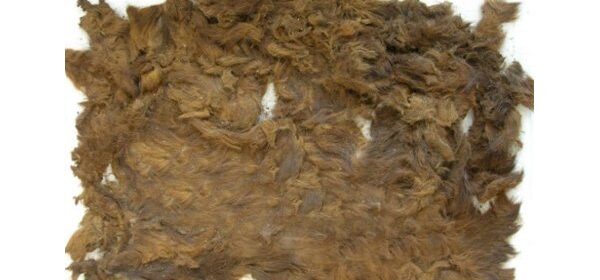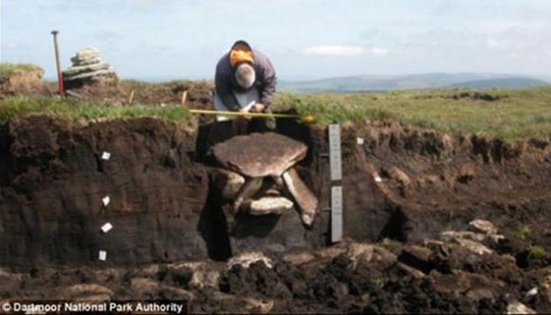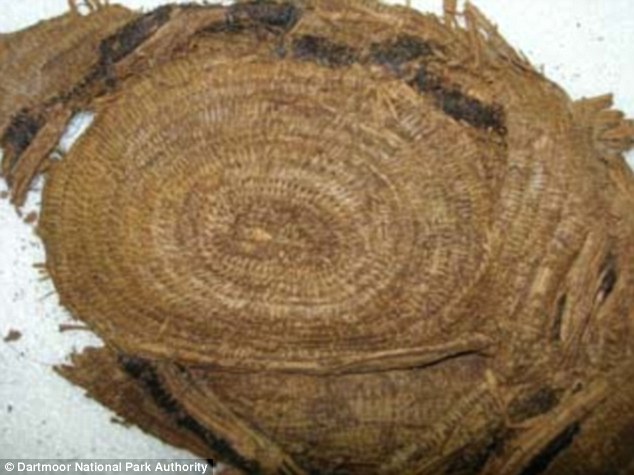4,000-year-old pelt found in princess grave reveals bears roamed Dartmoor, England

4,000-year-old pelt found in princess grave reveals bears roamed Dartmoor, England
Experts claim that bears once roamed the Dartmoor hills after analyzing an ancient pelt buried with the remains of a Bronze Age princess.
The animal skin was found in a bog on White Horse Hill in 2011. It was discovered wrapped around woven baskets and cremated human remains in the grave.
The fur and exotic beads found at the 4,000-year-old site suggest that the grave was for a high-status individual.

‘It’s entirely possible bears were living in the local area,’ said Fiona Pitt, curator of Plymouth Museum, where the grave finds are on show.
‘We think bears were spread around Britain at the time. Their natural habitat was around woodland so they may have been around Dartmoor.’
Typical DNA analysis methods failed because of the effect of the bog on the pelt, so it was sent to the Smithsonian Institute in the US where a process called peptide mass fingerprinting was used.
Vanessa Straker, English Heritage’s science advisor for the South West said: ‘Finding the right technique to analyse it took some time. The results indicated that the pelt once belonged to a brown bear.
‘We thought it would be one of the easiest finds to identify – it looked very well preserved – but these things are so rarely preserved at all that we have little experience of working on them.’ Other discoveries at the 4,000-year-old site include a hoard of about 150 beads.

‘Some of the beads were made from the amber which would have been traded from abroad, suggesting a person of high social status,’ said Ms Pitt. In February, experts said that the buried artefacts could have belonged to a Bronze Age princess.
The basket held a collection of precious beads, wooden earrings and a flint flake, shedding light on an advanced society capable of amazing craftsmanship and international trade.
The objects were the subject of a BBC 2 documentary in March called ‘Mystery on the Moor,’ in which viewers saw the coiled bag opened for the first time in 4,000 years.
The basket bag is fashioned from two circular disks measuring 4.5 inches (12cm) in diameter to form a flat base and lid, which is joined by a tube made using a coiled basketry technique with cow hair stitching around the edge and was preserved in peat.
The wooden earrings inside, which measure up to an inch (2.5cm) in diameter, have side grooves and are made from spindle wood – a hard, fine-grained tree that grows in Dartmoor which is traditionally used to make knitting needles.
Archaeologists think the yo-yo-shaped studs were worn in the ears or set into leather belts or other clothing. ‘The studs are unique in British prehistory; they also represent the earliest evidence for woodturning in the UK,’ experts at the Dartmoor National Park Authority said.
Archaeologists have used the objects to build up a picture of the person who was buried at the site on Whitehorse Hill and it is thought they were of considerable importance in the local community.
They speculate that the items, which also include precious jewellery, belonged to women between the ages of 14 and 25-years-old, who was probably a princess.
An expert at Dartmoor National Park Authority told MailOnline that archaeologists came to this conclusion as another lesser, comparable items have been founded in prehistoric cairns.
The princess was of incredibly high social standing, as evidenced by the high position of her final resting place 600 metres above sea level on the northern moors, which would have been visible to nearby settlements and the valuable items that were buried with her.

Archaeologists first stumbled across the chamber a decade ago when a stone fell out of the peat hag which had been concealing it – far from other known prehistoric sites.
‘The find fills in the blanks of the local map in terms of Bronze Age settlements, as before there was little evidence of inhabitation, so there must be a settlement nearby,’ one local expert told MailOnline.
‘There’s much more to discover in the area,’ he said. A skilfully-made decorative sash or belt was folded around the cremated remains along with the pelt. It is composed of textile and leather with a fringe of outward-pointing leather triangles made from thin calfskin.
But the discovery of beads made of tin initially got archaeologists particularly excited because they are the earliest evidence of tin production found in the South West. Over 200 beads were plucked from and around the basket and some are made from amber.
The precious material from the Baltic was associated with supernatural powers and used as an amulet, which therefore suggests a very high-status burial as well as demonstrating that Bronze Age Britons traded with people from the continent.
A delicate woven bracelet with tin studs was also unearthed. A total of 35 tin studs are held in place by a band of woven cow hair. While the metal has oxidized, it would have been shiny in appearance.
‘The use of tin for decorative objects is exceptionally rare within prehistoric burial contexts in Britain and despite tin being a locally available resource on Dartmoor, this is the first time it has been found within a prehistoric archaeological context,’ local experts said. Ms Pitt said: ‘This is the most outstanding site to have been excavated locally in over 100 years.’
‘The items that were discovered in the cist are of national and international importance and provide one of the best glimpses into life in Bronze Age southern England that academics and scientists have ever had.’ The artefacts have just gone on display at Plymouth City Museum and Art Gallery.